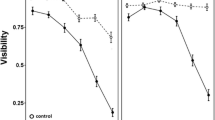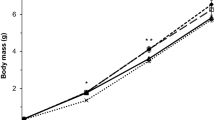Abstract
Larval western toads (Bufo boreas) are known to exhibit antipredator behavior in response to both chemical alarm cues released from injured conspecifics and chemical cues of predatory invertebrates. In this study, we tested whether long-term exposure to predator and alarm cues resulted in an adaptive shift in life history characteristics of the toads. We raised groups of tadpoles in the presence of: (1) predatory backswimmers (Notonecta spp.) that were fed toad tadpoles, (2) nonpredatory water boatman (Corixidae), and (3) chemical alarm cues of injured conspecifics. Tadpoles raised in the presence of both chemical alarm cues and cues of predators fed tadpoles metamorphosed in significantly shorter time than those raised in the presence of the nonpredator control. Reducing time taken to reach metamorphosis would reduce exposure to aquatic predators. There was no difference among treatments in the size at metamorphosis. Our results suggest that this shift in metamorphic characteristics may represent a facultative alteration in life history.
Similar content being viewed by others
REFERENCES
Ball, S. L., and Baker, R. L. 1996. Predator-induced life history changes: Antipredator behavior costs or facultative life history shifts. Ecology 77:1116-1124.
Chivers, D. P., and Smith, R. J. F. 1998. Chemical alarm signalling in aquatic predator/prey interactions: A review and prospectus. Écoscience 5:338-352.
Chivers, D. P., Wisenden, B. D., and Smith, R. J. F. 1996. Damselfly larvae learn to recognize predators from chemical cues in the predator's diet. Anim. Behav. 52:315-320.
Crowl, T. A., and Covich, A. P. 1990. Predator-induced life history shifts in a freshwater snail. Science 247:949-951.
DeVito, J., Chivers, D. P., Kiesecker, J. M., Marco, A., Wildy, E. L., and Blaustein, A. R. 1998. The effects of snake predation on metamorphosis of western toads, Bufo boreas (Amphibia, Bufonidae). Ethology 104:185-193.
Dodson, S. I., and Havel, J. E. 1988. Indirect prey effects: Some morphological and life history responses of Daphnia pulex exposed to Notonecta undulata. Limnol. Oceanogr. 33:1274-1285.
Gosner, K. L. 1960. A simplified table for staging anuran embryos and larvae with notes on identification. Herpetologica 16:183-190.
Hews, D. K. 1988. Alarm response in larval western toads, Bufo boreas: Release of larval chemicals by a natural predator and its effect on predator capture efficiency. Anim. Behav. 36:125-133.
Hews, D. K., and Blaustein, A. R. 1985. An investigation of the alarm response in Bufo boreas and Rana cascadae tadpoles. Behav. Neural Biol. 43:47-57.
Kats, L. B., and Dill, L. M. 1998. The scent of death: Chemosensory assessment of predation risk by prey animals. Écoscience 5:361-394.
Kiesecker, J. M., Chivers, D. P., and Blaustein, A. R. 1996. The use of chemical cues in predator recognition by western toad tadpoles. Anim. Behav. 52:1237-1245.
Kulzer, E. 1954. Untersuchungen über die Schreckreaktion bei Erdkrotenkaulquappen (Bufo bufo L.). Z. Tierpsychol. 36:443-463.
Lima, S. L., and Dill, L. M. 1990. Behavioral decisions made under the risk of predation: A review and prospectus. Can. J. Zool. 68:619-640.
Mathis, A., and Smith, R. J. F. 1993. Fathead minnows, Pimephales promelas, learn to recognize northern pike, Esox lucius, as predators on the basis of chemical stimuli from minnows in the pike's diet. Anim. Behav. 46:645-656.
Minchella, D. J., and Loverde, P. T. 1981. A cost of increased early reproductive effort in the snail Biomphalaria glabrata. Am. Nat. 118:876-881.
Petranka, J. W. 1989. Response of toad tadpoles to conflicting chemical stimuli: Predator avoidance versus “optimal” foraging. Herpetologica 45:283-292.
Pfeiffer, W. 1966. Die Verbreitung der Schreckreaktion bei Kaulquappen und dei Herkunft des Schreckstoffes. Z. Vergl. Physiol. 52:79-98.
Sih, A. 1987. Predator and prey lifestyles: an evolutionary and ecological overview, pp. 203-224, in W. C. Kerfoot and A. Sih (eds.). Predation: Direct and Indirect Impacts on Aquatic Communities. University Press of New England, Hanover, New Hampshire.
Sih, A., and Moore, R. D. 1993. Delayed hatching of salamander eggs in response to enhanced larval predation risk. Am. Nat. 142:947-960.
Skelly, D. K. 1992. Field evidence for a cost of behavioral antipredator response in a larval amphibian. Ecology 73:704-708.
Skelly, D. K., and Werner, E. E. 1990. Behavioral and life-historical responses of larval American toads to an odonate predator. Ecology 71:2313-2322.
Stabell, O. B., and Lwin, M. S. 1997. Predator-induced phenotypic changes in crucian carp are caused by chemical signals from conspecifics. Environ. Biol. Fish. 49:145-149.
Tabachnick, B. G., and Fidell, L. S. 1989. Using Multivariate Statistics. New York: Harper Collins.
Van Buskirk, J. 1988. Interactive effects of dragonfly predation in experimental pond communities. Ecology 69:857-867.
Werner, E. 1986. Amphibian metamorphosis: growth rate, predation risk and the optimal size at transformation. Am. Nat. 128:319-341.
Wilbur, H. M., and Fauth, J. E. 1990. Experimental aquatic food webs: Interactions between two predators and two prey. Am. Nat. 135:176-204.
Wildy, E. L., Chivers, D. P., and Blaustein, A. R. 1999. Shifts in life history traits as a response to cannibalism in larval long-toed salamanders (Ambystoma macrodactylum). J. Chem. Ecol. 1999.
Wilson, D. J., and Lefcort, H. 1993. The effect of predator diet on the alarm response of red-legged frog, Rana aurora, tadpoles. Anim. Behav. 46:1017-1019.
Author information
Authors and Affiliations
Rights and permissions
About this article
Cite this article
Chivers, D.P., Kiesecker, J.M., Marco, A. et al. Shifts in Life History as a Response to Predation in Western Toads (Bufo boreas). J Chem Ecol 25, 2455–2463 (1999). https://doi.org/10.1023/A:1020818006898
Issue Date:
DOI: https://doi.org/10.1023/A:1020818006898




